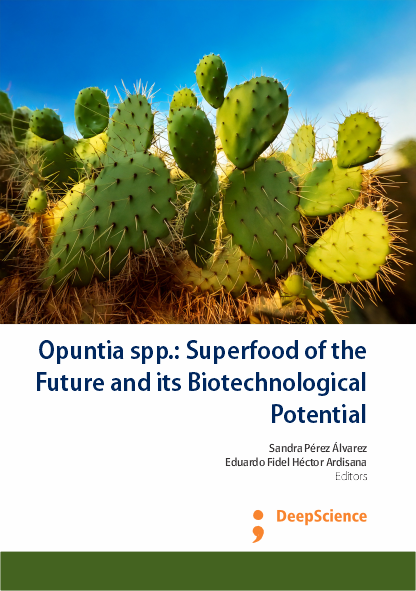Traditional uses and modern applications in food systems of Opuntia spp.
Synopsis
El-Mostafa et al. (2014) and Aruwa et al. (2018) stated that Opuntia ficus-indica (L.) Mill. is a cactus belonging to the Cactaceae family and is the most widely cultivated species, not only in Mexico but also worldwide (Martins et al., 2023). This crop can grow in desert and semi-desert areas despite limited water, poor soils, and high temperatures (Aragona et al., 2017).
As drought has become more frequent in recent years because of climate change, this crop is an alternative for the production of high-quality food since it adapts to the lack of water because they are CAM plants (Crassulacean Acid Metabolism), which means that CO2 fixation occurs at night, when cacti open their stomata, reducing both transpiration and water loss (Khodaeiaminjan et al., 2021). The flowers can be a source of bioactive compounds for food preservation (Ammar et al., 2012) because of the presence of red and yellow betalains and several phenolic compounds (Silva et al., 2021; Feugang et al., 2006). The fruits and cladodes can be used as food, and even possess nutraceutical due to their various components. Cladodes have fibres, carbohydrates, minerals [phosphorus (P), magnesium (Mg), calcium (Ca), potassium (K), and some others], reducing sugars, proteins, lipids (Feugang et al., 2006; Stintzing et al., 2005) and if they are young also have chlorophyll, ascorbic acid and carotenoids. The fruits, known as prickly pears, contain fibres, sugar, amino acids, water, ascorbic acid, minerals, and antioxidants (phenols, carotenoids, flavonoids, and betalains (Silva et al., 2021; Scarano et al., 2022).
The variation of the nutritional and antioxidant components of this crop depends mainly of agronomic parameters (fertilization, type of soil, irrigation type and frequency), temperatures and plant genetic (Inglese et al., 2017).
Some authors report the use of parts of the nopal or substances extracted from it as food or for obtaining other products. For example, in the confectionery industry, nopal pectin was used to create cocoa gelatin (Pilligua Piguave, 2017). The leaves (cladodes) are commonly consumed in Mexico, either cooked or as fresh vegetables, known as nopalitos (Dubeux et al., 2021). Third-generation snacks made with nopal and rice flours have also been developed (Anchondo-Trejo et al., 2021), and jams have been made from the pulp of the fruit (Barba et al., 2020). Alternatively, the mucilage removed from the leaves of O. robusta species has been used as a stabilizer produced to make mayonnaise (Bernardino-Nicanor et al., 2015), and the addition of mucilage removed from O. ficus-indica improved the quantities of bioactive composites in the bread (Liguori et al., 2020).
- Historical Significance, Nutritional Profile and Health Benefits of Opuntia
Nopal has been part of the Mexican history and it appears in the national coat of arms. It is part of the basic Mexican diet like beans and corn (Torres-Ponce et al., 2015).
The coasts of Mexico have marked their early beginnings with nopal, for many of the species growing there are native to Mexico. This species was used during the pre-Hispanic period by various cultures living in the region. Nopal was utilized in several ways, such as food and medicine, in construction and also for making arts. The same functions persisted during the colonial era, continuing from the time they were first observed in pre-Columbian times (Mills, 1824; Anaya-Pérez, 2001).
For ages, the species belonging to the genus Opuntia have been used in traditional medicine and as food because of therapeutic and nutritional properties for the control of several chronic conditions like diabetes, obesity, cardiovascular illnesses, and cancer (Santos-Diaz et al., 2017). Some of the nutritional properties provided by the fruit include low acidity (0.03-0.12%), high sugar content (12-17%), high levels of P, K and Ca, low sodium (Na) content, and a higher vitamin content compared to bananas, apples, grapes and other popular fruits (Yahia & Mondragon- Jacobo, 2011).
The medicinal properties of plants of the Opuntia genus are given by their nutritional content. According to Izuegbuna et al. (2019) and Khazdair et al. (2019) paddles of Opuntia spp. have a great amount of minerals [Mg, K, Fe (iron) and Ca], vitamins with antioxidant functions like a β-carotene (vitamin A) in amounts comparable to spinach (Spinacia oleracea L.) and also an elevate content of vitamin C. Furthermore, the prickly pear shovels as food, can provide the human body with eight very important amino acids (valine, histidine, leucine, phenylalanine, threonine, isoleucine, methionine, and lysine) (Knishinsky, 2004; Koshak et al., 2021). Additionally, vegetarians people can get a substantial amount of high-quality protein from the blades (Li et al., 2020; Madrigal-Santillán et al., 2022).














